"We could go anywhere with this song; it was definitely going to go to big places."
-Paul McCartney, The Beatles Anthology
About/Info[]
"A Day in the Life" is the thirteenth and final track of the 1967 Beatles' eighth studio album, Sgt. Pepper's Lonely Hearts Club Band. Credited to Lennon–McCartney, the verses were mainly written by John Lennon, with Paul McCartney primarily contributing the song's middle section. It is widely regarded as one of the finest and most important works in popular music history. Lennon's lyrics were mainly inspired by contemporary newspaper articles, including a report on the death of Guinness heir Tara Browne. The recording includes two passages of orchestral glissandos that were partly improvised in the avant-garde style. In the song's middle segment, McCartney recalls his younger years, which included riding the bus, smoking, and going to class. Following the second crescendo, the song ends with a sustained chord, played on several keyboards, that sustains for over forty seconds. A reputed drug reference in the line "I'd love to turn you on" resulted in the song initially being banned from broadcast by the BBC. The ending chord is one of the most famous in music history. The song inspired the creation of the Deep Note, the audio trademark for the THX film company. Jeff Beck, Barry Gibb, the Fall and Phish are among the artists who have covered the song. John Lennon wrote the melody and most of the lyrics to the verses of "A Day in the Life" in mid-January 1967. Soon afterwards, he presented the song to Paul McCartney, who contributed a middle-eight section. In a 1970 interview, Lennon discussed their collaboration on the song:
Paul and I were definitely working together, especially on "A Day in the Life"...The way we wrote a lot of the time: you'd write the good bit, the part that was easy, like "I read the news today" or whatever it was, then when you got stuck or whenever it got hard, instead of carrying on, you just drop it; then we would meet each other, and I would sing half, and he would be inspired to write the next bit and vice versa. He was a bit shy about it because I think he thought it's already a good song...So we were doing it in his room with the piano. He said "Should we do this?" "Yeah, let's do that."
According to author Ian MacDonald, "A Day in the Life" was strongly informed by Lennon's LSD-inspired revelations, in that the song "concerned 'reality' only to the extent that this had been revealed by LSD to be largely in the eye of the beholder". Having long resisted Lennon and George Harrison's insistence that he join them and Ringo Starr in trying LSD, McCartney took it for the first time in late 1966. This experience contributed to the Beatles' willingness to experiment on Sgt. Pepper and to Lennon and McCartney returning to a level of collaboration that had been absent for several years.
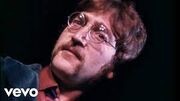
The thumbnail for the YouTube music video https://www.youtube.com/watch?v=usNsCeOV4GM
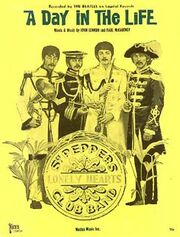
A Day in the Life sheet music paper
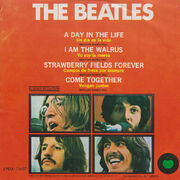
A Day in the Life 1967 video poster
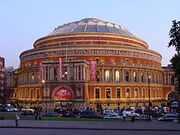
In his lyrics, Lennon mentions the Royal Albert Hall, a symbol of Victorian-era London and a concert venue usually associated with classical music performances.
Recording[]
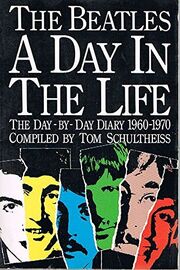
A Day in the Life: The Day-By-Diary
January 19, 1967, 7:30 pm–2:30 am — The first four takes of the song were recorded. John sang and played guitar and Paul played piano. Take 1 used only two of the four available tracks. At this time, they knew that something would go in the centre of the song, but they did not yet know what. The echoing voice of Mal Evans counted out the bars, from 1 to 24, accompanied by a tinkling piano with notes ascending in pitch in tandem with the numbers. An alarm clock sounded at the end, and this was ultimately kept in because, according to George Martin, they couldn't remove it! Take 4 consisted of John's vocal overdubs onto two tracks. By the end of the night, three of the four tracks available were replete with John's heavily echoed vocal.
January 20, 1967, 7:00 pm–1:10 am — Reduction mixdowns, vacating tracks for more overdubbing. Take 6 was marked "best" and was augmented with another John lead vocal, Paul's bass, and Ringo's drums. This day also marked the first appearance of Paul's vocal in the middle section. (It was a happy coincidence that the section began right after the alarm went off.) Paul would re-record his vocal on February 3 because this day's work was only a rough guide, and he cursed at the end as he flubbed his line.
February 3, 1967, 7:00 pm–1:15 am — More overdubs onto Take 6. Paul re-recorded his middle vocal and also his bass part. Ringo decided to wipe his original drum track in favour of a new and distinctive tom-tom sound. George Martin commented, "That was entirely his own idea. Ringo has a tremendous feel for a song and he always helped us hit the right tempo first time. He was rock solid and this made the recording of all the Beatles' songs so much easier."*
February 10, 1967 — This was one of the most auspicious days in Beatle history, the day the orchestra was brought in to play the instrumental build-up to fill the 24-bar gap between the John and Paul sections of the songs. Forty musicians (the Fabs originally wanted ninety) were instructed to play from a preselected low note to the highest note their instrument could reach. George Martin sketched out a chart with a squiggly line to suggest the ascent to the high note, and he was paid 18 pounds for his arrangement. The musicians were given somewhat unusual instructions: Start quietly and end loud; start low in pitch and end high; make your way up the scale independent of the other musicians around you. The orchestra cost EMI 367 pounds, 10 shillings. Martin and Paul took turns conducting, leaving Geoff Emerick in the control room to monitor the controls and capture the crescendo. The segment was recorded manipulating the acoustics of the room using "ambiophony," a rudimentary precursor of surround sound.
The recording session, which ran from 8:00 pm to 1:00 am, was an event. The musicians all wore formal evening attire, but they also donned novelty items such as clown noses, fake nipples, and gorilla-paw gloves. Recording was filmed with seven handheld cameras and edited, along with stock (non-Beatles) footage, into an early music video, but it was never broadcast. (It can be seen on the Anthology DVD.) Also on hand were Patti Boyd, Mick Jagger, Marianne Faithfull, Keith Richards and Mike Nesmith. Everyone in the studio broke into spontaneous applause after the last orchestral crescendo. When the orchestra left, the Beatles and friends stayed to record the final chord, a long "hummm," which would remain the song's ending until February 22.
February 13, 1967 — Four new mono mixes were prepared.
February 22, 1967 — The Beatles decided that the choir of humming voices was not powerful enough to end the song. John, Paul, Ringo and Mal Evans, sharing three pianos, simulaneously stuck an E major chord to replace the choir. The recording went nine takes before they all hit the chord at the right time. Take 9 was overdubbed thrice, and then George Martin added a Harmonium until all four tracks were filled. The concluding wall of sound lasted 53 seconds, although it faded about 10 seconds earlier on the record, because the speakers of the time could not handle the last super-soft sound. (The ending of the 1987 Sgt. Pepper CD also concludes in 43 seconds.)
February 23, 1967 — Geoff Emerick prepared a stereo master.
March 1, 1967 — A new piano track was added to Take 6. This overdub was never used.
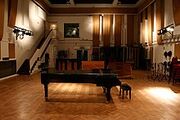
A grand piano in EMI's Studio Two, where the closing piano chord was recorded on 22 February 1967
April 21, 1967 — Recording of the The Inner Groove chatter. The Fabs recorded gibberish and funny noises, chopped up the tape, put it back together and threw it onto the track. (After the album was released, people of course played the chatter backward, and claims surfaced that it says something naughty. This is not true, according to Geoff Emerick, who swears there is no hidden meaning in the words.) They also recorded the high-frequency sound that only dogs can hear.
June 1, 1967 — First released on the UK LP Sgt. Pepper's Lonely Hearts Club Band.
Lyrics[]
Bolded lyrics were removed in later edits
[Verse 1]
I read the news today, oh boy
About a lucky man who made the grade
And though the news was rather sad
Well, I just had to laugh
I saw the photograph
He blew his mind out in a car
He didn't notice that the lights had changed
A crowd of people stood and stared
They'd seen his face before
Nobody was really sure if he was from the House of Lords
[Verse 2]
I saw a film today, oh boy
The English Army had just won the war
A crowd of people turned away
But I just had to look
Having read the book
[Refrain]
I'd love to tur-ur-urn you on
[Bridge]
Woke up fell out of bed
Dragged a comb across my head
Found my way downstairs and drank a cup
And looking up, I noticed I was late (huff-huff-huff)
Found my coat and grabbed my hat
Made the bus in seconds flat
Found my way upstairs and had a smoke
And somebody spoke and I went into a dream
[Interlude]
Ah-ah-ah-ah
Ah-ah-ah-ah-ah-ah-ah
Ah-ah-ah
Ah-ah-ah
Ah-ah-ah-ah-ah-ah-ah
[Verse 3]
I read the news today, oh boy
Four thousand holes in Blackburn, Lancashire
And though the holes were rather small
They had to count them all
Now they know many holes it takes to fill the Albert Hall
[Refrain]
I'd love to tur-ur-urn you on
[Outro]
Ha-oh-oh-oh (Time!)
I never could see any other way (buns on!)
I never could see any other way (buns on!)
I never could see any other way (buns on!)
I never could see any other way (buns on!)
I never could see any other way (buns on!)
I never could see any other way (buns on!)
I never could see any other way (buns on!)
I never could see any other way (buns on!)
I never could see any other way (buns on!)
I never could see any other way (buns on!)
Meaning[]
Tara Browne[]
Music critic Tim Riley says that in "A Day in the Life", Lennon uses the same lyrical device introduced in "Strawberry Fields Forever", whereby free-form lyrics allow a greater freedom of expression and create a "supernatural calm". According to Lennon, the inspiration for the first two verses was the death of Tara Browne, the 21-year-old heir to the Guinness fortune who had crashed his car on 18 December 1966. Browne was a friend of Lennon and McCartney, and had instigated McCartney's first experience with LSD. Lennon adapted the song's verse lyrics from a story in the 17 January 1967 edition of the Daily Mail, which reported the ruling on a custody action over Browne's two young children.
During a writing session at McCartney's house in north London, Lennon and McCartney fine-tuned the lyrics, using an approach that author Howard Sounes likens to the cut-up technique popularised by William S. Burroughs. "I didn't copy the accident," Lennon said. "Tara didn't blow his mind out, but it was in my mind when I was writing that verse. The details of the accident in the song – not noticing traffic lights and a crowd forming at the scene – were similarly part of the fiction." McCartney expounded on the subject: "The verse about the politician blowing his mind out in a car we wrote together. It has been attributed to Tara Browne, the Guinness heir, which I don't believe is the case, certainly as we were writing it, I was not attributing it to Tara in my head. In John's head it might have been. In my head I was imagining a politician bombed out on drugs who'd stopped at some traffic lights and didn't notice that the lights had changed. The 'blew his mind' was purely a drugs reference, nothing to do with a car crash."
Four-thousand holes[]
Lennon wrote the song's final verse inspired by a Far & Near news brief, in the same 17 January edition of the Daily Mail that had inspired the first two verses. Under the headline "The holes in our roads", the brief stated: "There are 4,000 holes in the road in Blackburn, Lancashire, or one twenty-sixth of a hole per person, according to a council survey. If Blackburn is typical, there are two million holes in Britain's roads and 300,000 in London." The story had been sold to the Daily Mail in Manchester by Ron Kennedy of the Star News agency in Blackburn. Kennedy had noticed a Lancashire Evening Telegraph story about road excavations and in a telephone call to the Borough Engineer's department had checked the annual number of holes in the road. Lennon had a problem with the words of the final verse, however, not being able to think of how to connect "Now they know how many holes it takes to" and "the Albert Hall". His friend Terry Doran suggested that the holes would "fill" the Albert Hall, and the lyric was eventually used.
Drug culture[]
McCartney said about the line "I'd love to turn you on", which concludes both verse sections: "This was the time of Tim Leary's 'Turn on, tune in, drop out' and we wrote, 'I'd love to turn you on.' John and I gave each other a knowing look: 'Uh-huh, it's a drug song. You know that, don't you?'" George Martin, the Beatles' producer, commented that he had always suspected that the line "found my way upstairs and had a smoke" was a drug reference, recalling how the Beatles would "disappear and have a little puff", presumably of marijuana, but not in front of him. "When [Martin] was doing his TV programme on Pepper", McCartney recalled later, "he asked me, 'Do you know what caused Pepper?' I said, 'In one word, George, drugs. Pot.' And George said, 'No, no. But you weren't on it all the time.' 'Yes, we were.' Sgt. Pepper was a drug album."
The English Army[]
Author Neil Sinyard attributed the third-verse line "The English Army had just won the war" to Lennon's role in the film How I Won the War, which he had filmed during September and October 1966. Sinyard said: "It's hard to think of [the verse] without automatically associating it with Richard Lester's film."
Creation[]
Though many believe the first verse was referring to the death of Tara Browne, a young London socialite who was also from a noble Irish family and heir to the Guinness beer fortune, whose recent death in a car crash had been reported in the newspaper, George Martin has said that this was a drug reference. The line "I'd love to turn you on" is often believed to be a drug reference with no relation to the rest of the song. In interviews John Lennon has said that the car crash was the primary inspiration for this song.[citation needed] The last verse about potholes was originally about a newspaper article talking about how the road to the Albert Hall was full of potholes. However, he couldn't figure out how to connect "Now they know how many holes" and "Albert Hall", so Lennon's friend Terry Doran suggested the word "fill".[citation needed] The middle section about an uneventful morning was contributed by McCartney. The line "I'd love to turn you on" was also contributed by McCartney. In an interview, Lennon said that that one line that was the supposed drug reference was just a random line that McCartney contributed that had nothing to do with the rest of the song.[citation needed]
Reception/Legacy[]
A Day in the Life is famous through the Beatles community for being the best song they ever made, and is one of their most popular songs of all time. A Day in the Life was immediately praised after Sgt. Pepper's Lonely Hearts Club Band was released, millions of fans saying that A Day in the Life was the perfect culmination between John Lennon's and Paul McCartney's singing, and the Beatles' vision, ambition, and execution flawlessly come together in five and a half minutes, and the song being the perfect ending to Sgt. Pepper's.
Credits[]
- John Lennon — Lead Vocals, Rhythm Guitar (Gibson J-160E), Piano (Final E Chord only) (Hamburg Steinway Baby Grand)
- Paul McCartney — Backing Vocals (Lead Vocals during bridge), Piano (Full) (1905 Steinway Vertegrand), Bass Guitar (Rickenbacker 4001S)
- George Harrison — Maracas
- Ringo Starr — Drums, Congas, Piano (Final E Chord only) (1905 Steinway Vertegrand)
- Mal Evans — Alarm clock, Vocals, Piano (Final E Chord only) (1964 Challen Upright Piano)
- George Martin — Harmonium (Mannborg)
- John Marston – Harp
- Erich Gruenberg, Granville Jones, Bill Monro, Jurgen Hess, Hans Geiger, D. Bradley, Lionel Bentley, David McCallum, Donald Weekes, Henry Datyner, Sidney Sax, Ernest Scott, Carlos Villa –Violin
- John Underwood, Gwynne Edwards, Bernard Davis, John Meek – Viola
- Francisco Gabarro, Dennis Vigay, Alan Delziel, Alex Nifosi – Cello
- Cyril Mac Arther, Gordon Pearce –-Double Bass
- Roger Lord -Oboe
- Basil Tschaikov, Jack Brymer –Clarinet
- N. Fawcett, Alfred Waters –Bassoon
- Clifford Seville, David Sandeman –Flute
- Alan Civil, Neil Sanders –French Horn
- David Mason, Monty Montgomery, Harold Jackson -Trumpet
- Raymond Brown, Raymond Premru, T. Moore –Trombone
- Michael Barnes –Tuba
- Tristan Fry –Timpani
